Review: 2013 Infiniti JX35 Take Two
Infiniti has characteristically taken the path less travelled. The original Q45 was styled to express Japanese culture (rather than imitate the Germans), tuned for drivers, and infamously advertised with video of rocks and trees. The brand finally hit its stride thirteen years later with the compact rear-wheel-drive G35. It jumped on the crossover bandwagon with a pair of cozy cabined, firmly suspended, VQ-propelled eggs. Those seeking space for their family and their family’s stuff had a choice between the massive truck-based QX56 and something that wasn’t an Infiniti (often an Acura MDX). Market and dealer pressure to offer something much closer to the norm was no doubt intense. So, for 2013, we have the Infiniti JX35 (originally reviewed by Derek Kreindler). Has the brand’s character been overly compromised, or is this the crossover Infiniti should have offered from the start?
Recent Infinitis have been curvaceous, even bulbous. You won’t find fuller forms on any other new car lot. With the JX35, Infiniti clearly struggled with an inherent conflict between this design language and the need to offer competitive interior space. The JX’s exterior is an incompletely resolved combination of a curvy M-like front end (dominated by an over-sized grille and emblem) and a space-maximizing box. A “crescent-shaped” D-pillar is distinctive, but there’s probably an aesthetic reason that explains why it’s never been done before. Expect it to spread to other Infinitis as they are redesigned.
Inside the JX35, Infiniti has also backed off its usual tendencies in order to cater to the typical large crossover buyer. The interior is styled to resemble those in other Infinitis, so it’s easy on the eyes, but the forms are much different. The instrument panel and console are less curvy and less intrusive. The seats are flatter, nearly bolster-free, and less cushy. As a result, the JX feels less “tailored to fit” (or, for larger people, not fit) than other Infinitis. The appeal isn’t as deep, but it’s much broader.
Infiniti is very proud of the way the JX’s second-row split bench folds forward. With no child seat in it, the cushion folds up tightly against the backrest GM Lambda-style to open up a very wide path to the third row. Infiniti’s innovation: unlike in the Lambdas, if you strap in a child seat the bench can still slide forward enough to permit people to squeeze through. There’s no need to order captain’s chairs (that aren’t offered) to maintain access to the third row with child seats in the second row.
In other respects the JX’s rear passenger accommodations are nothing special. As in most crossovers (Ford’s being the major exception), the seats are flat and are mounted too low to the floor to provide adults with thigh support. And as in too many luxury vehicles, there isn’t any space under the front seats for the toes of second-row passengers, essentially reducing second-row legroom by about four inches. There’s still plenty of legroom in the second row if the bench is shifted fully rearward along its five inches of travel. But, again all too typically, if the second row is all the way back there’s very little legroom in the third row. Ultimately, there’s just enough space to fit average-sized men in all three rows if everyone limits their legroom to the amount they absolutely need. To Infiniti’s credit, the third row is better ventilated than most, so the kids won’t bake back there. Behind the third row you’ll find 15.8 cubic feet of cargo volume, about the same as in an Acura MDX. My five-person family’s luggage wouldn’t fit without folding at least half of the third row.
There’s considerably more space for both people and cargo inside a Buick Enclave. But Infiniti’s marketing people never mention the Enclave as a competitor. They prefer to talk about the Acura MDX and Audi Q7, both of which have tighter third rows than the JX and both of which have gone six years since a thorough redesign. But, in terms of specs and configuration, the Buick is actually the JX’s closest competitor. Inside, the Buick wins on quantity, the Infiniti on quality (unless GM has worked wonders with the 2013 refresh).
With a powertrain and chassis derived from the Nissan Murano (and shared with the upcoming 2013 Pathfinder), the JX35’s performance neither delights nor disappoints. Even with all-wheel-drive curb weight is a very reasonable 4,419 pounds, so the 3.5-liter V6’s 265 horsepower are sufficient. The mandatory CVT assists by holding the engine in its power band when this is required. I personally didn’t mind the behavior of the CVT. If you do, select sport mode and it mimics a conventional six-speed automatic. Go WOT with front-wheel-drive and there’s some torque steer and front-end float, but not nearly enough to by themselves justify all-wheel-drive. Unlike in the MDX, which has an oversteer-inducing rear differential, the JX’s all-wheel-drive system doesn’t significantly enhance the driving experience on dry roads.
Fuel economy according to the EPA is 18 city / 24 highway with front-wheel-drive and 18/23 with all-wheel-drive, similar to the numbers earned by large domestic crossovers. The trip computer reported about 21 on my largely exurban driving route (infrequent stops, speed typically between 40 and 60). Given the vehicle’s relatively low curb weight and CVT, it should be capable of better. Blame the aging VQ V6 engine.
The JX’s ride and handling are similarly sufficient for the vehicle’s intended mission. The steering is light but well-weighted, and even provides some feedback if you’re paying close attention. Body motions and lean are fairly well controlled, but rush the JX and it feels heavy and out of its element, lapsing into a safe, dull plow. Did I really expect otherwise, even with the Technology Package’s “active trace control”? Hope, perhaps. Expect, no. The ride is generally smooth and quiet, though there’s some “head toss” over uneven roads (a by-product of thick stabilizer bars) and some minor jitters over patchy pavement (the standard 18-inch wheels might help–the tested vehicles all had the optional 20s). One “feature” that few people will notice, or be bothered by if they do: the 60 side of the second row often vibrates, as if it’s harmonizing with a frequency in the suspension.
The Infiniti JX starts at $41,400. Add $1,100 for all-wheel-drive. Tick all of the major boxes and the sticker’s bottom line reaches $54,800, which is $540 below a 2012 Acura MDX Advance with Entertainment Package. But the ancient Acura lags in the safety nannies department, while the oh-so-2013 JX has them all (ICC, FCW, BCI, DCA, BSW, BSI, LDW, LDP, XYZ, PDQ, WTF). BCI—Back-up Collision Intervention—is a first: if the system detects that you’re about to back up into something, it automatically stops the vehicle. Between this feature and the around-view monitor Infiniti pioneered a few years ago (I’m a fan), the paint on the JX’s rear bumper should be good for the long haul. Use TrueDelta’s car price comparison tool to assign typical values to these features, adjust the price accordingly, and the JX emerges with a nearly $3,700 price advantage over the MDX. Compared to a loaded 2012 Buick Enclave, a similarly-equipped JX lists for $1,890 less before adjusting for feature differences and about $3,200 less afterwards. Even though the Infiniti can be optioned into the mid-fifties, it’s actually a good value. Willing to forego the fancy bits for a lower price? Nissan has a closely related Pathfinder on the way.
In the end, I’m not sure how to answer the question posed by the introduction. In the next few years, I’m going to take my kids on a grand tour of the western national parks from Arizona to Alberta. When I do, I’d like a roomy three-row vehicle with an athletic chassis. I like how Infinitis drive, my wife likes how they look and feel. They might have stuck to their characteristic way of doing things and created our ideal family truckster. But the entire auto industry has realized the pointlessness of catering to fecund driving enthusiasts taking once-in-a-lifetime Rocky Mountain road trips. The Cadillac SRX lost its barely-there third row and shifted to a front-wheel-drive platform. The relatively car-like Mercedes-Benz R-Class was vastly outsold by the clumsier GL. Lexus never delivered a planned driver-focused GS-based crossover, instead peddling the RX, GX and LX. Infiniti paid its car guy dues with the EX and FX; the former has sold poorly, the latter just a bit better. So the JX, which takes the emerging segment norm and dresses it like an Infiniti, is only a surprise in that it didn’t happen years ago. Unless you get off on safety nannies, there’s no wow, and little in the way of driving excitement. But there’s a lot of nice. The big question isn’t whether the JX will sell–it will–but how many other Infinitis will head down the same path.
Infiniti provided a couple of the tested JXs, fuel, insurance, airfare to Charleston, a fancy boutique hotel, and excellent food. Bill French at Suburban Infiniti of Novi provided another JX so I could test the ride on Michigan roads. Bill can be reached at 888-779-2907.
Michael Karesh operates TrueDelta.com, an online source of car reliability and real-world fuel economy information.
Michael Karesh lives in West Bloomfield, Michigan, with his wife and three children. In 2003 he received a Ph.D. from the University of Chicago. While in Chicago he worked at the National Opinion Research Center, a leader in the field of survey research. For his doctoral thesis, he spent a year-and-a-half inside an automaker studying how and how well it understood consumers when developing new products. While pursuing the degree he taught consumer behavior and product development at Oakland University. Since 1999, he has contributed auto reviews to Epinions, where he is currently one of two people in charge of the autos section. Since earning the degree he has continued to care for his children (school, gymnastics, tae-kwan-do...) and write reviews for Epinions and, more recently, The Truth About Cars while developing TrueDelta, a vehicle reliability and price comparison site.
More by Michael Karesh
Latest Car Reviews
Read moreLatest Product Reviews
Read moreRecent Comments
- Kwik_Shift_Pro4X Thankfully I don't have to deal with GDI issues in my Frontier. These cleaners should do well for me if I win.
- Theflyersfan Serious answer time...Honda used to stand for excellence in auto engineering. Their first main claim to fame was the CVCC (we don't need a catalytic converter!) engine and it sent from there. Their suspensions, their VTEC engines, slick manual transmissions, even a stowing minivan seat, all theirs. But I think they've been coasting a bit lately. Yes, the Civic Type-R has a powerful small engine, but the Honda of old would have found a way to get more revs out of it and make it feel like an i-VTEC engine of old instead of any old turbo engine that can be found in a multitude of performance small cars. Their 1.5L turbo-4...well...have they ever figured out the oil dilution problems? Very un-Honda-like. Paint issues that still linger. Cheaper feeling interior trim. All things that fly in the face of what Honda once was. The only thing that they seem to have kept have been the sales staff that treat you with utter contempt for daring to walk into their inner sanctum and wanting a deal on something that isn't a bare-bones CR-V. So Honda, beat the rest of your Japanese and Korean rivals, and plug-in hybridize everything. If you want a relatively (in an engineering way) easy way to get ahead of the curve, raise the CAFE score, and have a major point to advertise, and be able to sell to those who can't plug in easily, sell them on something that will get, for example, 35% better mileage, plug in when you get a chance, and drives like a Honda. Bring back some of the engineering skills that Honda once stood for. And then start introducing a portfolio of EVs once people are more comfortable with the idea of plugging in. People seeing that they can easily use an EV for their daily errands with the gas engine never starting will eventually sell them on a future EV because that range anxiety will be lessened. The all EV leap is still a bridge too far, especially as recent sales numbers have shown. Baby steps. That's how you win people over.
- Theflyersfan If this saves (or delays) an expensive carbon brushing off of the valves down the road, I'll take a case. I understand that can be a very expensive bit of scheduled maintenance.
- Zipper69 A Mini should have 2 doors and 4 cylinders and tires the size of dinner plates.All else is puffery.
- Theflyersfan Just in time for the weekend!!! Usual suspects A: All EVs are evil golf carts, spewing nothing but virtue signaling about saving the earth, all the while hacking the limbs off of small kids in Africa, money losing pits of despair that no buyer would ever need and anyone that buys one is a raging moron with no brains and the automakers who make them want to go bankrupt.(Source: all of the comments on every EV article here posted over the years)Usual suspects B: All EVs are powered by unicorns and lollypops with no pollution, drive like dreams, all drivers don't mind stopping for hours on end, eating trays of fast food at every rest stop waiting for charges, save the world by using no gas and batteries are friendly to everyone, bugs included. Everyone should torch their ICE cars now and buy a Tesla or Bolt post haste.(Source: all of the comments on every EV article here posted over the years)Or those in the middle: Maybe one of these days, when the charging infrastructure is better, or there are more options that don't cost as much, one will be considered as part of a rational decision based on driving needs, purchasing costs environmental impact, total cost of ownership, and ease of charging.(Source: many on this site who don't jump on TTAC the split second an EV article appears and lives to trash everyone who is a fan of EVs.)



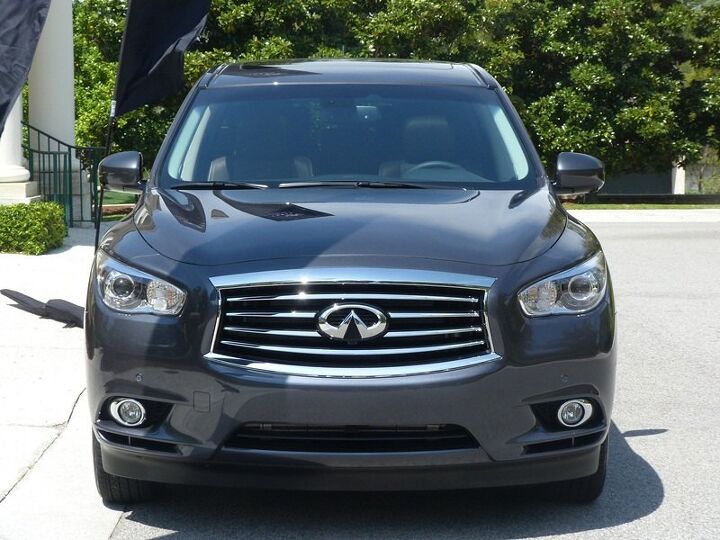

























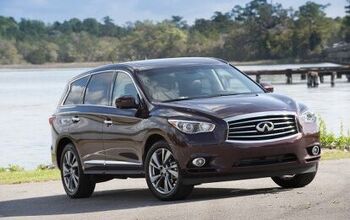
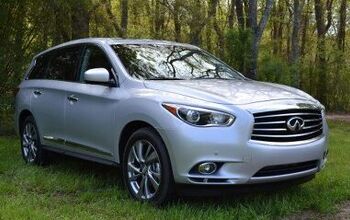
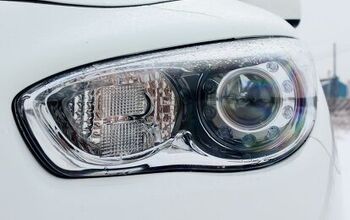
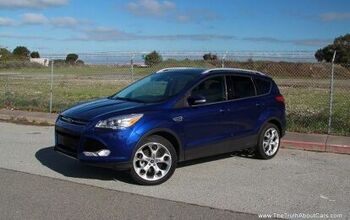











Comments
Join the conversation
I just ordered a JX 35 after test driving the MDX (too cramped), the R350 (ride too boxy and no third seat), the Benz R class (too small) and many more. The closest competitor was the fully loaded Toyota Highlander Limited, except it lacked the rear sensors I had gotten so used to in my Toyota Sienna (2003). The JX is spacious, has the third row I occasionally need and has the amenities I wanted. I didn't get all the avoidance tech but got what I wanted. That being said, I would have purchased another Sienna if Toyota would get rid of their horrible run flat tires on the all wheel drive model and hadn't changed the interior getting rid of the features I used most. The odyssey was just rediculous IMO. A refrigerator? Just give me back the extra storage that was there before.
The Infiniti is great. What "auto-enthusiast" expects a 3 row crossover to drive like a 911?